LOG FROM A CITIZEN SCIENCE EXPEDITION

Published March 14, 2017
Chris Cantele
Explorer at CC’s Wanderlust
Recently, I returned from a truly wonderful scuba diving expedition — Participating in a Citizen Science Program aboard the Quino el Guardian — my mission, to dive and monitor the entire length of The Baja Peninsula on The Sea of Cortez. During the journey, I kept a journal of the trip as we sailed over 850 miles from the southern tip of the Baja Peninsula to Puerto Penasco in northern Mexico…
The Start — Day 1 and 2
First night after dinner an announcement was made that the Port Master closed the area due to a pending Hurricane…. The ship was tied down and we settled in for the night…
Overnight, the storm passed, and the Harbor Master gave the okay for our departure… The Sun came out strong, storm moved north. The waves rounding the Harbor were huge (6-8 foot swells), several people were feeling a bit green.
We did our first two dives off Cabo at Chileno North and South. The water was murky from the storm but plenty of marine life — fish, sea fans and sponges.
The afternoon brought our first science lesson and microscope viewing on Sea Fan varieties. The purpose was to give us an idea of what we’d be looking at as we moved through the expedition.
Day 3 — What a day… Highlights included
Three dives in Cabo Pulmo – a National Protected Marine Area (MPA). Feeling like Alice in Wonderland. Very hallucinogenic. Schools of literally thousands of fish along a 30 million year old reef system where the tectonic plates were crusted with shell fossils.Key sightings included Electric Rays and Porcupine Fish engaged in an elaborate mating dance.
Afternoon lesson on counting fish aggregations and how to set up underwater grid systems. We will be making counts all the way up the Baja. Comparing impacts from climate change in areas protected versus non-protected areas.
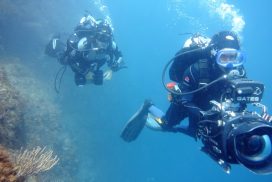
Last night, after dinner, we had a lesson on identification of different species of Sea Cucumber. Looked at their skin cells under electron microscope. Super trippy.
Sailed toward Espiritu Santo and Los Isoletes in prep for the next day’s diving.
Days 3 and 4 — Beyond Cell Reach
Out of cell service range for a couple days… Very remote unpopulated areas. Basically we sleep, eat, dive, eat, dive, talk, eat, dive, eat, lesson, sleep. Meals are super plentiful, beautiful and delicious. Lunch and dinner are multiple courses. They are basically cooking all day long. Whatever is cooking wafts into the cabin… Often trumped by garlic.
Yesterday was a good day of diving various parts of Los Isoletes where the top underwater action focused on a sea lion rookery. For the first 2 dives, they seemed pretty content simply sunning themselves on the rocks… As the afternoon sun sufficiently warmed them, they ventured into the water to check us out. Primarily the young pups as Mom and Dad kept an eyeful watch.
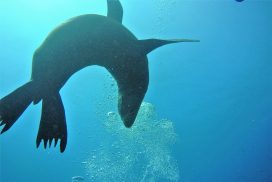
In the evening we headed to a protective bay of Espiritu Santo to have dinner and prepare for a night adventure of stationing lights down 20 feet to attract Mobula Rays and a full strata of marine life from Zooplankton on up. The La Paz scientist scooped up the various types of plankton and we viewed that under the Microscope.
Day 5 — We are at Animas Island
Fairly uneventful diving. This spot has been clearly over-fished to the point of depression. Thankfully the hamburger con queso with papas fritas lifted my mood.
It’s now after lunch and we are off to the next island. Laying on my bunk watching the tranquil waters, the Baja mainland and low puffy clouds pass by.
Third dive was at San Diego Barrier Reef. Literally a rock barely sticking out of the open sea. Pristine, stunning, colorful. Very healthy and full of all kinds of coral, sea fans, and teaming with schooling tropical fish. Likely the healthiest reef I’ve seen since the 1980's.
I believe we are now heading toward Loretto…
Day 6 — Education
Greetings from the islands just south of Loretto.
Excuse the past, present and future tense that may appear as I am treating this as a journal.
Last night, Francisco gave a lecture on Echinoderms (starfish, sea cucumbers, brittle stars, urchins). Very fascinating and really cool 3-D animation… Connected it to the ancient Maya in terms of things they found and used in ceremony throughout Mexico and found in excavation.
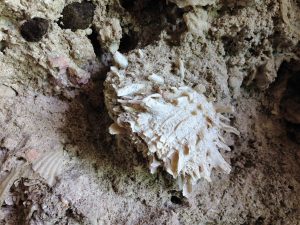
Today, we are diving sites around Danzante (dancing island) — Danzante island and mainland Baja make for a large, protected bay. Surrounded by high desert mountains, the land looks liked it was airbrushed with mint green as with the recent double hurricanes the arid landscape is experiencing a second spring.
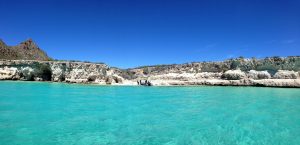
We took an educational excursion to one of the islands (after breakfast 1, dive, breakfast 2, dive and lunch)… to visit an 8 million year old cave. Landed at Playa el Cendero (stunning). We got a lesson from Carlos and Francisco on the millions of shell fossils seen in the strata. You could see the different layers where the ancient reef system built upon itself. We then were shown live specimens of many varieties of starfish and how they related to the evolution of the ancient sea dwellers.
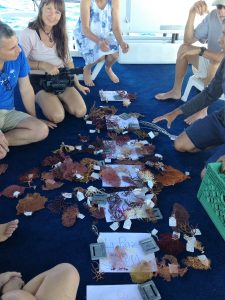
I've been told that in 4 days we will be heading to "whale channel" to hopefully dive with Sperm Whale… Please, please, pretty please. That is my marine Mecca.
Day 7 — Evolution
As we approached Coronado Island at dawn, day 7, we were greeted by the sea lions welcoming barks. The scientists (taxonomists and environmentalists – Francisco Solis and Carlos Sanchez) continue their collection of animals specific to each island and region. This trip reminds me of the book I read by Charles Darwin as he sailed through the Galápagos Islands penning his theory of evolution…. As they are taking exact specimens, measurements, and counts at different elevations in the water column and underwater topography. Charles was, however, missing the element of Scuba.
Francisco Solis is from Mexico City and one of only 7 Scientists in the world within his field. Carlos is also a taxonomist (study the architecture of skeletons) but is now using his 30 years of experience helping to preserve the Sea of Cortez through environmentalism. Both men have worked together over the years on projects involving Cortez.
Our first dive, the deepest yet at 120 feet, was Piedra Blanco. This was unique in that at the depth it featured a massive garden of yellow polyp black coral and white gorgonians. We were also treated to a Spotted Eagle Ray with 6′ wingspan!
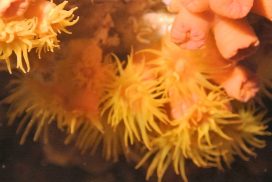
A side note on many of the dive sites. There are massive aggregations of recently hatched fish. Very tiny but clouds of them the size of football fields. You are literally swimming through clouds of millions and millions of fish. Large fish swim through with their mouths wide open enjoying a bounty of the sea.
All the islands I’ve mentioned are massive undulations of sedimentary rock (sandstone, granite, volcanic pumice, ancient reef), completely uninhabited with the exception of cactus garden, blue footed boobies, osprey, sea lion and some insects. Last evening we had a colony of honeybee fly out to the boat seeking fresh water. They drank off wetsuits, out if rinse buckets and flew back to land, very satisfied.

OMG! Second dive Coronado Island began with several young sea lions playing with us at 60’… They’d give you a playful “nip”, look at you and want some rubbing and play… Continued down the reef until we came upon hundreds of Chevron Barracuda in the quintessential cyclonic pattern. Then, if it could get any better, (16) 4-5′ Mobula rays cruised overhead above the barracuda. Spectacular!
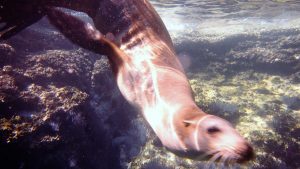
Making way toward our next stop in Loretto. It will be a short evening stop to see a few land sites (Loretto Mission Square, etc., update provisions). After that we will likely fall back out of cell range again as we enter part 2 of the trip — northern Sea of Cortez.
Day 8 — Nostalgic
One of the crew, Rana (frog) – actual name Juan – takes a picture every day and emails it to his wife. His wife and young daughter have made a map. They together are printing out the photo that Juan sends each day and placing it on the map… So they can see where dad has been and to see what he is seeing. They are on the trip with him.
Many of the Mexican men (crew) are taking photos and show them to me and others. They are all in awe of the natural surrounds and seem just as excited as we are in what we’re discovering together. This in a very unique trip in that — to now — is the first of it’s kind.
First dive today was Punta Pulpito (the pulpit). Very nice finger reef. Loaded with Yellow Tail Surgeon fish, two turtles and 2 schools of Mobula rays (3 and 16). My dive buddy is Ricardo (from Sao Paolo, Brazil). He is an excellent buddy in that we have similar diving styles. We both like to cruise, cover great distance and search in the open blue for the big stuff.
We’ve just been welcomed to the next island (Isla San idlefonso) by a flock of 6 seabird (brown boobies sans nib lit) riding the airfoils and literally flying to our hands on the bow. In addition they were joined by a lone osprey. They made 7 circles around the boat, always coming back to us closer each time until I felt a wing in flight). After that, they landed in the water and stayed with the boat.
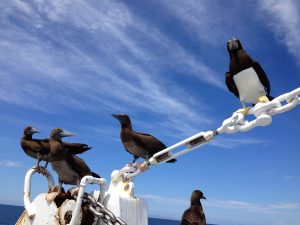
Prior to dive 3, Ramiro made a presentation via both microscope and PowerPoint on a couple of species of coral and the symbiotic relationship of tiny crabs specific to them. Stag Horn Hermit Crab… Harvested for aquariums en masse at $28 each but don’t last long in tanks. This also included the life cycles and life stories of each — reproduction, territory, dominance, etc.
3rd dive site — I renamed the Canyon lands or The Alps. Spectacular underwater sea canyons set about a half mile off shore. Felt like we were flying over the mountains with peaks, valleys, etc. saw 3 beautiful turtles. 2 Greens and not sure on the 3rd.
Back in the cabin reading before dinner with tonight’s garlic-based feast wafting through. There have been a few days without it… But it’s back!
15 hour cruise tonight to get to our first destination in Northern Baja – whale and whale shark territory! Also, second time change … Now two hours behind central time.
Day 9 — Northern Cortez
We have steamed into the krill and plankton rich waters of Northern Cortez and weighed anchor off of San Pedro Martir — an uninhabited but history rich island. The island was originally inhabited by native Indian slaves from northern Mexico. The slaves harvested bird guano. As a result of the nutrient rich soil, the massive island is covered in Cacti Forrest. You can also see terraced walls where the guano was compiled.
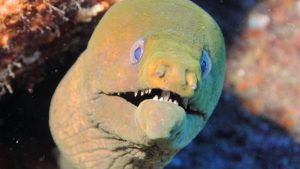
The first dive was a site called Arrollo. The water was much darker and a few degrees cooler. The big difference (and reason for the darkness) is the presence of massive blooms of krill and plankton…. Perfect for the upcoming next two days of whales and whale sharks.
Hey… Change of course. After the second dive in nutritious, green murk, crew decided to go searching for whales instead of the next dive.
Success! Swam with a pod of Orcas… Mom, dad and baby Orca plus a couple other adults. We saw them make 4 passes right beneath us in open Sea. Very stunning. Can hardly believe that I saw that in open sea.
After dinner, both Carlos and Francisco made presentations — Carlos’ was on symbiotic relations of black coral (that we’ve seen gardens of on the dives) and a particular type of microscopic shrimp that has taken a million years of evolution to mimic the coral. He then showed us the actual specimens under microscope. Francisco discussed what it takes to publish works on his subjects.
Now… A night dive… Followed by the official time change. I’ve decided to pass on this, read and relax instead as they have another 4 dives planned for tomorrow… So far, I’ve done 20 dives of 23 and there will be at least 7 more on the way.
Day 10 — The Last Frontier
First two dives this morning. Clearly we are in another zone. The water is so plankton and krill rich, that this seems like the last frontier on earth. There are massive gardens of black coral, giant jaw fish, bulls eye electric rays, striped snake eels, tons of filter feeding Mobula Rays…. Also, lots of really strong current.
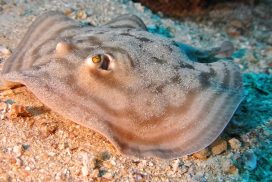
Tonight they grilled Carne Asada
On the top deck. Yummy. You truly cannot believe this food. Like being in the best Mexican Restaurant for 5 meals a day. I’ve gained at least 5 pounds.
Day 11 — The largest fish on earth
After the first early dive Punta Don Juan — where we saw a school of Bulls Eye Puffer Fish and many variety of sting ray, we are now on our way to search and snorkel with Whale Sharks!
Heading to Bahia de Los Angeles where we will be met by local environmental group that is going to take us out in search of the largest fish in the ocean.
OMG. Spent the last two hours in a beautiful bay swimming with whale sharks — sizes ranging from 12 feet to over 35 feet! I had a 35 footer come right up under me and I ended up on top of it rolling all the way from head to the slap of its tail… I was airborne!!!
Been cruising for a couple hours in Whale Channel. The smell of a chocolate chip desert baking in the kitchen. So far, we’ve spotted a Fin Whale and a massive pod of Common Dolphin...
Day 12 — Devils Point
Awoke to the stunning sunrise at our last dive site — Punta Diablo.
Was the perfect place to end the diving portion of the trip. We were greeted by a pod of Dolphin searching for breakfast along the rocky reef. The landscape looked like pictures from Mars meeting the Sea. The underwater terrain was simply stunning offering clear blue water, tons of fish life and macro subjects.
After the dive, we had a boat tour of the sea caves. Amazing. We entered the cave by boat and looked at the ancient lava tubes and bats hanging in their dark, moist aquatic lair.
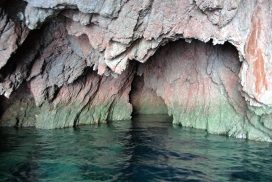
After another very delicious lunch of tamarind juice, sautéed veggies and a delicious beef burrito, we set course for our end point, Puerto Penasco.
It will be a 15 hour journey during which we will have workshops and films on pieces related to what we’ve seen over the past 13 days.
Post Log — Protecting the Marine Environment
During our 13 days together, the scientists collected samples from each of the 30 dives and dozen islands. The surveyors mapped every inch of the reef systems visited, spending countless hours underwater. They made fish counts in each area to compare the current conditions to past years. The research will be used to support recommendations that more areas need to become official MPA’s (Marine Protected Areas). The surveys will ultimately help define, compare and contrast MPA areas versus non-MPA areas, supporting that the marine environments do much better as they are protected, whether commercial fishing continues or not. Additionally, we have seen that communities which give up fishing to promote tourism do much better both economically and the marine areas bounce back and flourish.
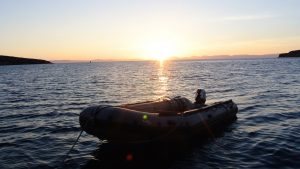
In terms of my experience, these words do not completely convey what it felt like to be on the water seeing the Baja Peninsula in it’s entirety. The magnificent sunrises and sunsets, the creatures and landscape, the fellowship, the passion and laughter shared among fellow travelers of the oceans… made for a simply terrific experience!
Here’s a short video of my trip. I hope you enjoy it!

